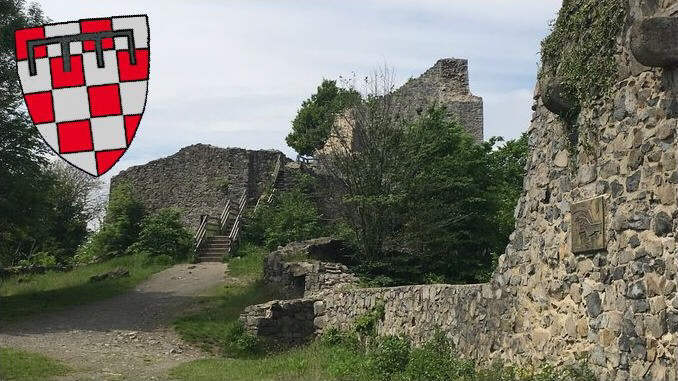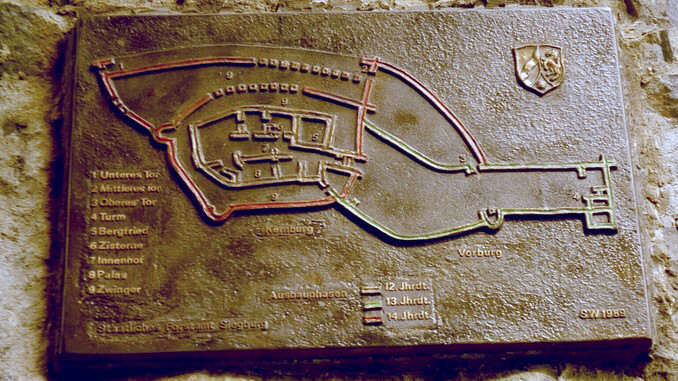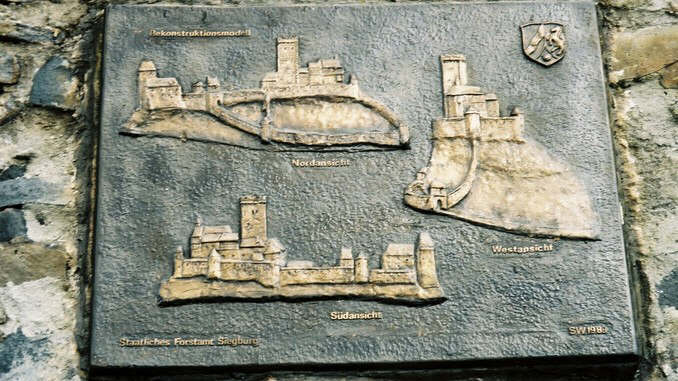
From up here at Löwenburg Castle, you have a wonderful view across the Rhine Valley and the other hills. You almost feel like the lord or the lady of the castle. Thanks to conservation and restoration work, we can visit the castle ruin.
The castle ruins
You enter the castle area through the gate, at that time there was certainly a gatehouse with guards. Here in the outer castle, the lower castle, once stood the farm buildings and the accommodation of the castle team. You can still see the remains of a rectangular tower and a half-shell tower. In the wall around the core castle you can see the embrasures.
The wooden stairs lead up to the upper castle, the core castle, the oldest part of the Löwenburg. Here at the “front corner” to the entrance is the keep. It was rebuilt up to a third of its original height. Even if enemies had made it up the Löwenburg, the keep from which one would take them under fire must have had a deterrent effect. Here in the upper castle were the residential buildings of the lords of the castle (palas). Looking at the reconstruction drawing, it must have been a two-story, and there was a chapel, a castle kitchen and a cistern to collect rainwater.
The castle, whose ruins we see today, was built in the second half of the 13th century, and the outer bailey came into being around 1400. However, the beginnings Löwenburg Castle go back to around 1200.
The beginnings
Count Heinrich II von Sayn (1172-1202) had Löwenburg Castle built towards the end of the 12th century. Back then, it was just a simple tower house. Unlike with Drachenfels Castle, we do not have exact dates, Löwenburg Castle does not appear in the historical sources until 1247. Some authors date it to the war years around 1200, others to an earlier date around 1180.
Let us go back in time to those years in our region. The mighty archbishops of Cologne held Castle Wolkenburg and Castle Drachenfels. The Counts of Sayn had become powerful men too, large areas along the river Sieg were theirs. Since 1180, their mighty castle Blankenburg stood above the Sieg valley. Count Heinrich’s wife had brought the area around Mount Löwenburg into the marriage.
The Counts of Berg did not have possessions in the Siebengebirge yet, however at the Sieg river the Counts of Sayn had gotten in their way, Blankenburg Castle must be been a thorn in their side. Both counts, however, were liege men to the archbishop of Cologne and met his ambitions with suspicion. So, it must have been an uneasy peace at the Cologne feudal court.
War for the throne and feud
A terrible time began in 1198, when the war for the throne broke out between Philip of Swabia, the youngest brother of the deceased Emperor Henry VI, and Otto IV, Welf by his father Henry the Lion and Plantagenet by his mother Matilda of England and his uncle Richard I. Lionheart. As Cologne was Otto’s stronghold, the Rhineland was devastated.
The counts of Sayn stood firmly on Otto’s side. An embittered feud raged between them and Dietrich of Landsberg, a supporter of the Hohenstaufen. Count Heinrich II. von Sayn and his brother Eberhard were taken prisoner by Dietrich and died of the hardships they had suffered. Only the marriage between Count Henry III of Sayn and Dietrich’s daughter Mechthild of Landsberg around 1215 ended the feud.

A border fortress
We know little about the first years of Löwenburg Castle since it doesn’t appear in the historical sources until 1247. Unlike the Sayn family castle in Bendorf (Rhineland-Palatinate) and the big fortress above river Sieg in Blankenburg, Löwenburg Castle was just a border fortress in the outskirts of Sayn territory.
Mechthild had brought the Thuringian landed property in the Westerwald into the marriage. Since she was on her mother’s side a granddaughter of the Thuringian Landgrave, her husband became a member of the high nobility and a powerful prince who was in contact with kings and emperors. Most likely, they didn’t often come to Löwenburg Castle.
Count Henry III and Mechthild had no children, and when he died 1247, the county went over to his sister’s family. Hard times began for his widow Mechthild. In his will, the Count had decreed that she could have, among other possessions, Löwenburg castle for her lifetime, but it seems that her husband’s relatives insisted that she gave it to them almost right away. Already in 1248, ¾ of Castle Löwenburg were theirs, Mechthild never moved in, and around 1268/69 she gave up all rights on Löwenburg Castle. She died in 1284/85.
Lords of Löwenberg
The next generation on Löwenburg Castle called themselves “of Löwenberg”, namely Johann I and Heinrich I. They had the old watchtower torn down and built the castle whose ruins we see today. We meet Johann at Reitersdorf Castle too. So now we are with the men who built the castle whose ruins we see today.
They lived in turbulent times. Count Johann I. von Heinsberg had inherited Löwenburg Castle. However, the Count of Wolkenburg, the Knights of the Teutonic Order in the nearby village Ramersdorf and an officer of the archbishopric of Cologne disputed his rights. They even chased him out of his Löwenburg Castle and his territories.
Back then, Johann I. started building the small castle down by the Rhine in Reitersdorf. We know little about these years of turmoil and armed conflicts, and the fragments do not give a true picture. Perhaps he had Reitersdorf Castle built as substitute for Löwenburg. Finally, the archbishop of Cologne, Engelbert von Valkenburg, managed to settle the dispute, and Johann I could move into Löwenburg Castle and rightfully call himself “Lord of Löwenberg”.

Rivalries
The archbishops of Cologne and the Counts of Berg became embittered enemies, which eventually led to the bloody battle of Worringen. The archbishop and his allies, among them Johann, were defeated, he was taken prisoner and became an involuntary liege man of the Count of Jülich. During the following years, Johann often got caught in the crossfire, and he stroke back.
Johann I married twice, and he had sons from both marriages. When he died in 1306, his son Heinrich I became Lord of the Löwenburg (1306-1343).
After the sudden death of Holy Roman Emperor Henry VII in Italy in 1313, there was a double election. The majority of the prince-electors voted for Louis IV of the House of Wittelsbach, acting Count Palatine. We also refer to him as “Louis the Bavarian”. The minority, however, voted for the Frederick “the Fair” of the House of Habsburg. Among them was the archbishop of Cologne, Heinrich II of Virneburg. Again a double election led to civil war.
This war also divided the family on Löwenburg Castle. Heinrich I was on the archbishop’s side, so he supported Friedrich of Habsburg. His stepbrother Johann II from his father’s second marriage, however, was on the Count of Jülich’s side. They supported Louis. Reitersdorf Castle belonged to Johann II. Again our region was devastated by a war. That is to say, the opponents destroyed their enemies’ farms and houses, depriving people of their livelihood. Only in 1325 did Heinrich I and Johann II reconcile.
Push and shove
The most powerful men were the counts, from 1380 onwards, the dukes of Berg, and they kept fighting against the Archbishops of Cologne over predominance. Again and again both sides raided our region. Back then, the town of Königswinter was fortified by a city wall, and the Löwenburg castle by an outer bailey. Eventually, in 1484, Löwenburg Castle and the estates around it fell to the counts of Berg.

Be the first to comment